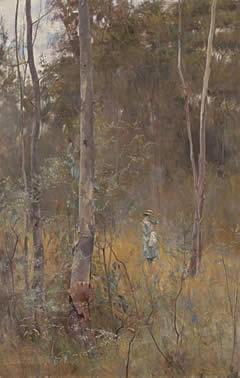Introduction
Many of the flowering plants which typify the Australian bush have firm to rigid leaves. Plants with leaves like this are termed
sclerophylls
(from the Greek sclero: hard, rigid and phyllon: leaf). In contrast
mesophytes
(from the Greek, meso: intermediate and phyton: plant), which have softer and generally larger leaves, are largely restricted to wetter forests such as rainforests and tall open forests.
The term sclerophylly
in Australian environments means more than just having rigid leaves. In this activity we will examine what sclerophylly means using a range of families as examples, and look at how
sclerophyllous
plants are adapted to Australian environments.
McCubbin was a Melbourne painter of the Heidelberg School. The vegetation in "Lost 1886" is presumably what was once typical around Box Hill (a suburb about 15 km east of Melbourne) and is an open forest, often referred to as a dry
sclerophyll
forest. Note the open canopy, with a mixture of herbs and grasses in the understorey.
Red text is linked to the glossary.

Frederick McCubbin, 1855-1915, Australia
Lost 1886, oil on canvas
115.8 x 73.7 cm
Felton Bequest, 1940, NGV Melbourne
